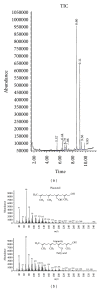Acute and chronic oral toxicity of a partially purified plaunotol extract from Croton stellatopilosus Ohba
- PMID: 24286075
- PMCID: PMC3806312
- DOI: 10.1155/2013/303162
Acute and chronic oral toxicity of a partially purified plaunotol extract from Croton stellatopilosus Ohba
Abstract
Plaunotol, an acyclic diterpenoid with highly effective antigastric ulcer properties, has been commercially isolated from leaves of Croton stellatopilosus Ohba. This Thai medicinal plant was traditionally used in the form of crude extracts, suggesting that it is possible to administer these plaunotol-containing extracts without toxicity. To confirm its safety, the oral toxicity of a partially purified plaunotol extract (PPE) was evaluated in vivo. The PPE was simply prepared by 95% ethanol reflux extraction followed by hexane partition. The obtained extract was analyzed and found to contain 43% w/w of plaunotol and another compound, likely a fatty acid-plaunotol conjugate that is considered a major impurity. Oral administration of PPE to ICR mice and Wistar rats was conducted to evaluate acute and chronic toxicity of the plaunotol extract, respectively. The acute toxicity study demonstrated that PPE was practically nontoxic based on its high median lethal dose value (LD₅₀ = 10.25 g/kg). The chronic toxicity studies also showed the absence of mortality and clinical symptoms in all rats treated with 11-1,100 mg/kg/day of PPE during a 6-month period. Histopathological and hematological analyses revealed that altered liver and kidney function and increased blood platelet number, but only at the high doses (550-1,100 mg/kg/day). These results suggest that PPE is potentially safe for further development as a therapeutic agent in humans.
Figures




Similar articles
-
In vitro study of the effects of plaunotol on oral cell proliferation and wound healing.J Asian Nat Prod Res. 2011 Feb;13(2):149-59. doi: 10.1080/10286020.2010.546790. J Asian Nat Prod Res. 2011. PMID: 21279879
-
Genetic variation of Croton stellatopilosus Ohba based on non-coding DNA sequences of ITS, trnK and trnL-F regions.J Nat Med. 2011 Jul;65(3-4):641-5. doi: 10.1007/s11418-011-0536-8. Epub 2011 Apr 16. J Nat Med. 2011. PMID: 21499847
-
Cloning and expression of 1-deoxy-d-xylulose 5-phosphate synthase cDNA from Croton stellatopilosus and expression of 2C-methyl-d-erythritol 4-phosphate synthase and geranylgeranyl diphosphate synthase, key enzymes of plaunotol biosynthesis.J Plant Physiol. 2010 Mar 1;167(4):292-300. doi: 10.1016/j.jplph.2009.09.001. Epub 2009 Sep 25. J Plant Physiol. 2010. PMID: 19782428
-
Molecular cloning, bacterial expression and functional characterisation of cytochrome P450 monooxygenase, CYP97C27, and NADPH-cytochrome P450 reductase, CPR I, from Croton stellatopilosus Ohba.Plant Sci. 2014 Dec;229:131-141. doi: 10.1016/j.plantsci.2014.09.001. Epub 2014 Sep 16. Plant Sci. 2014. PMID: 25443840
-
Final report on the safety assessment of capsicum annuum extract, capsicum annuum fruit extract, capsicum annuum resin, capsicum annuum fruit powder, capsicum frutescens fruit, capsicum frutescens fruit extract, capsicum frutescens resin, and capsaicin.Int J Toxicol. 2007;26 Suppl 1:3-106. doi: 10.1080/10915810601163939. Int J Toxicol. 2007. PMID: 17365137 Review.
Cited by
-
Investigating the Antibacterial Effects of Synthetic Gamma-Lactam Heterocycles on Methicillin-Resistant Staphylococcus aureus Strains and Assessing the Safety and Effectiveness of Lead Compound MFM514.Molecules. 2023 Mar 12;28(6):2575. doi: 10.3390/molecules28062575. Molecules. 2023. PMID: 36985547 Free PMC article.
-
Local Wisdom and Diversity of Medicinal Plants in Cha Miang Forest in Mae Kampong Village, Chiang Mai, Thailand, and Their Potential for Use as Osteoprotective Products.Plants (Basel). 2022 Jun 1;11(11):1492. doi: 10.3390/plants11111492. Plants (Basel). 2022. PMID: 35684265 Free PMC article.
-
Anti melanogenic effect of Croton roxburghii and Croton sublyratus leaves in α-MSH stimulated B16F10 cells.J Tradit Complement Med. 2018 Apr 30;9(1):66-72. doi: 10.1016/j.jtcme.2017.12.002. eCollection 2019 Jan. J Tradit Complement Med. 2018. PMID: 30671368 Free PMC article.
References
-
- Salatino A, Salatino MLF, Negri G. Traditional uses, chemistry and pharmacology of Croton species (Euphorbiaceae) Journal of the Brazilian Chemical Society. 2007;18(1):11–33.
-
- Sitthlthawom W, Potduang B, De-Eknamkul W. Localization of plaunotol in the leaf of Croton stellatopilosus Ohba. ScienceAsia. 2006;32(1):17–20.
-
- Shiratori K, Watanabe S, Takeuchi T, Chang J, Moriyoshi Y. Effect of plaunotol on release of plasma secretin and pancreatic exocrine secretion in humans. Pancreas. 1989;4(3):323–328. - PubMed
-
- Shiratori K, Watanabe S, Takeuchi T, Shimizu K. Plaunotol inhibits postprandial gastrin release by its unique secretin-releasing action in humans. Digestive Diseases and Sciences. 1990;35(9):1140–1145. - PubMed
-
- Koga T, Inoue H, Ishii C, Okazaki Y, Domon H, Utsui Y. Effect of plaunotol in combination with clarithromycin or amoxicillin on Helicobacter pylori in vitro and in vivo . Journal of Antimicrobial Chemotherapy. 2002;50(1):133–136. - PubMed
Publication types
MeSH terms
Substances
LinkOut - more resources
Full Text Sources
Other Literature Sources

